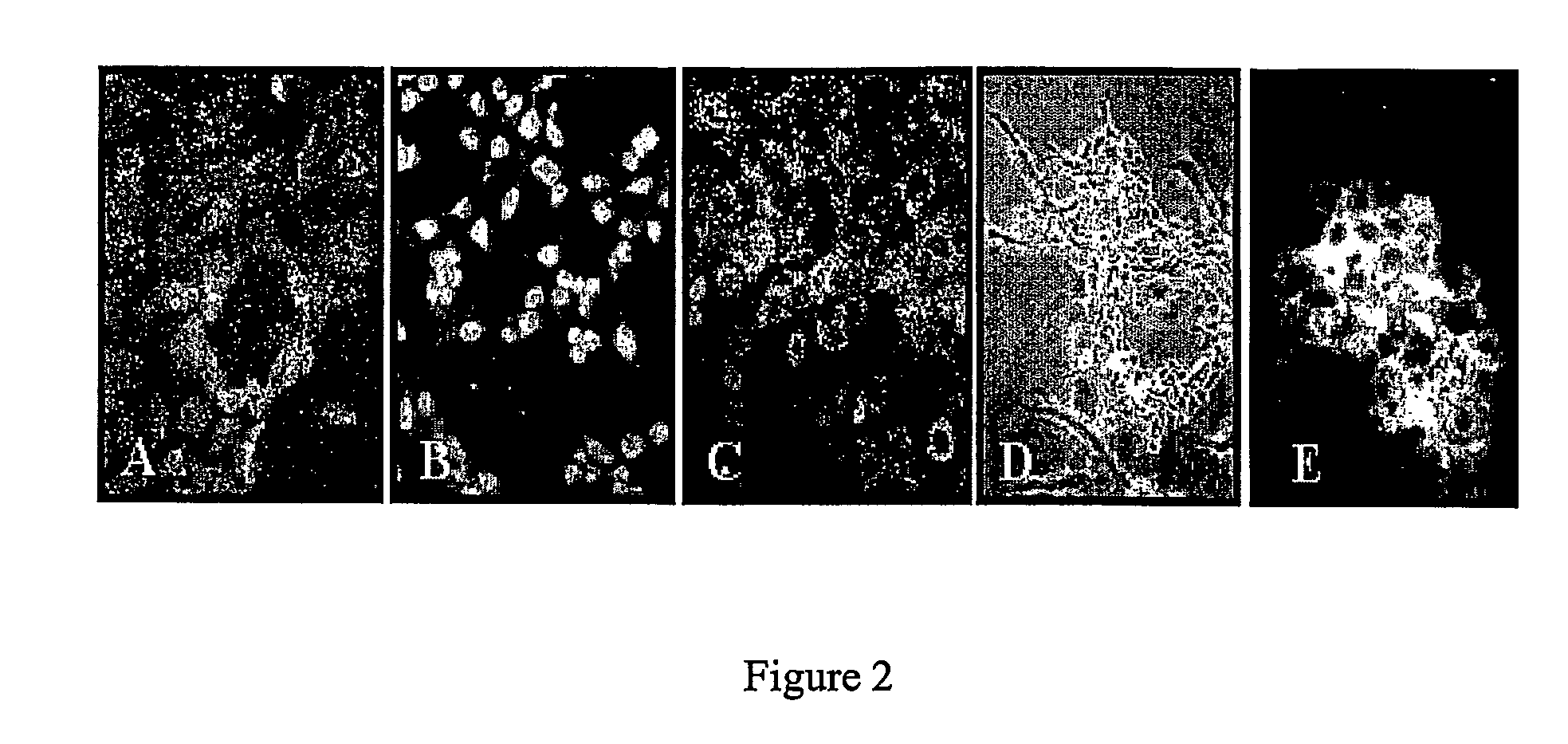Conversion of liver stem and progenitor cells to pancreatic functional cells
a technology of pancreatic function and liver stem cells, which is applied in the direction of genetically modified cells, prosthesis, metabolic disorders, etc., can solve the problems of regular insulin replacement therapy, preventing/reducing clinical complications, and not maintaining glucose levels near-normal range at all times to prevent/reduce clinical complications
- Summary
- Abstract
- Description
- Claims
- Application Information
AI Technical Summary
Problems solved by technology
Method used
Image
Examples
example 1
Liver Stem / Progenitor Cells
Liver epithelial cell lines with liver stem cell properties were developed from allyl alcohol (AA)-injured adult rat liver as described in Yin, L. et al. (2001 A); Yin, L. et al. (2001B); and Yin, L. et al. (2002). AA induces periportal liver injury, which is a liver injury model without the involvement of hepatocarcinogens (Peterson B. E. et al. (1998) Hepatology 27(4):1030-38). Five cell lines, named 1(1)#3, 1(1)#6, 1(3)#3, 2(11) and 3(8)#21, were chosen to investigate their potential of differentiation to pancreatic lineage cells. These 5 lines have been well characterized by Western blot, Northern blot, immunocytochemistry and histochemistry for various liver developmental, cell lineage markers and hematopoietic stem cell markers. The results are summarized in FIG. 1. Pictures of the immunocytochemistry results of the line 3(8)#21 are also presented in FIG. 1. Interestingly, almost all of the lines express hematopoietic stem cell markers CD34, Thy1.1...
example 2
Expression of Pancreatic Developmental and Cell Lineage Specific Genes in Liver Progenitor Cell Lines
These five (untreated) liver progenitor cell lines have been analyzed for the expression of selected pancreatic endocrine markers including insulin I and insulin II, pancreatic exocrine marker amylase, GLUT2 (glucose transporter), and some of the transcription factors that are critically involved in the development of pancreas such as Pdx1, Isl1, NeuroD / β2, Nkx6.1 and Pax4. The expression of these genes was determined by RT-PCR, and confirmed by Southern blot. The data is presented in FIG. 3. Rat pancreatic tissue expresses most of the markers tested including insulin I, insulin II, amylase, GLUT2, Pdx1, Isl1, and Nkx6.1 but not NeuroD / β2 and Pax4 (FIG. 3; lane 1). Gamma-irradiated STO feeder cells do not express any of these markers (FIG. 3; lane 2). Liver progenitor cell lines 1 (1)#3 (FIG. 3; lane 3) and 3(8)#21 (FIG. 3; lane 7) express almost all the pancreatic transcription fa...
example 3
Characterization of Expression in Liver Stem / progenitor Cells Under Different Experimental Conditions so as to Determine Their Differentiation Potential
Liver progenitor lines described herein are studied for expression of genes controlling the pancreatic development at different stages (Pdx1, Hlxb9, Isl1, ngn3, Nkx2.2, Pax6, NeuroD / β2, Nkx6.1, and Pax4), endocrine cell lineage markers (insulin I, insulin II, glucagon, somatostatin, and PP), exocrine markers (amylase and elastase), and the genes associated with insulin sensing, synthesis, process and secretion (GLUT-2, glucokinase, PC1, PC2, PC3 and carboxypeptidase E (CPE)). Each cell line is evaluated for expression under untreated and treated conditions. Treated cell lines are those that are grown under culture conditions known to enhance differentiation of pancreatic stem or progenitor cells, and / or are transfected with pancreatic development genes.
RT-PCR, Southern blot, immunocytochemistry, and Western blot techniques are us...
PUM
| Property | Measurement | Unit |
|---|---|---|
| Fraction | aaaaa | aaaaa |
Abstract
Description
Claims
Application Information
 Login to View More
Login to View More - R&D
- Intellectual Property
- Life Sciences
- Materials
- Tech Scout
- Unparalleled Data Quality
- Higher Quality Content
- 60% Fewer Hallucinations
Browse by: Latest US Patents, China's latest patents, Technical Efficacy Thesaurus, Application Domain, Technology Topic, Popular Technical Reports.
© 2025 PatSnap. All rights reserved.Legal|Privacy policy|Modern Slavery Act Transparency Statement|Sitemap|About US| Contact US: help@patsnap.com



